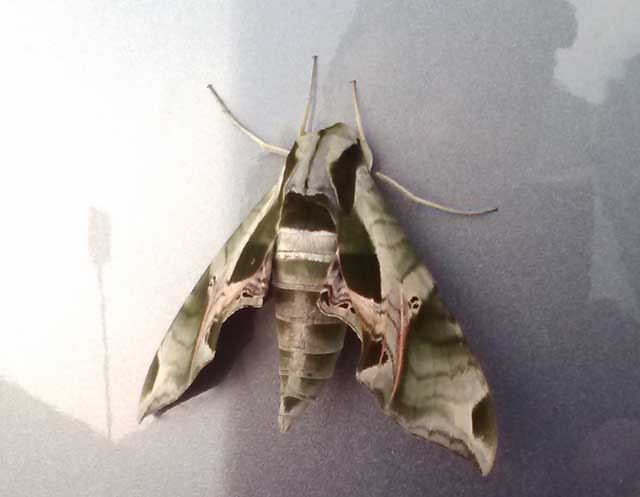Sphinginae subfamily
Sphingini tribe:
 |
Pink-spotted hawkmoth -- (Agrius cingulata) USGS
stray: Very strong flier, would only make its way to
Suffolk as rare stray. Not too many records from New York state, but records exist for NJ and CT.
|
 |
Ceratomia amyntor USGS,
Elm Sphinx, Four-horned Sphinx: Officially recorded in Suffolk.
Larvae feed on Elm (Ulmus), birch (Betula), basswood (Tilia), and
cherry (Prunus). |
Ceratomia amyntor, fifth instar larva on weeping birch, August 12, 2006, Bill Rue.
 |
Ceratomia catalpae USGS, Catalpa Sphinx:
This is generally a more southerly species, but it has been recorded in Suffolk.
I saw them in great numbers in New Jersey. The larvae feed in large groups and are much more
spectacular than the moths.
Catalpa is the larval host. |
 |
Ceratomia undulosa USGS, Waved
Sphinx. I have seen them as far north as P.E.I. in
eastern Canada, and took them in New Jersey. Named for the wavy lines on forewings. |
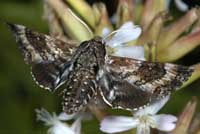 |
Dolba hyloeus USGS/HM, Pawpaw Sphinx:
Recorded in Suffolk. Widely reported in New Jersey and Connecticut.
|
Dolba hyloeus, Sag Harbour, July 22, 2011 Hugh McGuiness
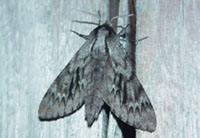 |
Lapara bombycoides USGS, Northern Pine Sphinx:
This moth is reported from Suffolk, and it is reported to the north, west and south. If you have pines, you probably have this species. It flies on P.E.I.
|
 |
Lapara coniferarum HM/ USGS, Southern Pine Sphinx:
Reported from Suffolk, widely reported in
New Jersey and along the coast in Connecticut and Masachusetts.
If you've got pines, this species is likely present. |
| Lapara coniferarum Long Island, July 20, 2005 Hugh McGuiness |
 |
This species is reported in Suffolk. Generally it is not
widely reported. |
 |
Manduca jasminearum USGS, Ash Sphinx: This species is officially recorded in Suffolk.
It is reported in New Jersey, southeastern New York and Connecticut.
|
 |
Manduca quinquemaculatus USGS, Five-spotted Hawkmoth:
Recorded in Suffolk, and it has been seen in nearby counties. I suspect if you grow tomatoes, you are likely to encounter it.
|
 |
Manduca rustica
WO, Rustic Sphinx: Has been taken in
several counties in northeastern New Jersey. I would not be surprised to get a report. Look for three large yellow spots
on each side of the abdomen.
|
 |
Manduca sexta USGS, Carolina Sphinx:
This species is recorded in Suffolk. If you grow tomatoes, you have probably encountered it.Larvae get very large and can strip a tomato plant.
|
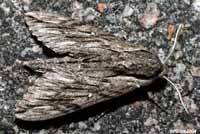 |
Paratrea plebeja USGS, Plebeian Sphinx:
Fw gray with indistinct black and white markings. There is a series of black dashes
from the base to the tip, and a small white cell spot.
|

|
Sphinx canadensis WO,
Canadian Sphinx, not common, not often reported anywhere, but might be present in Suffolk County as it is reported from
southern Ontario, Canada. Larval hosts are white ash (Fraxinus americana) and blueberry
(Vaccinium).
|
 |
Sphinx chersis USGS, Northern Ash Sphinx, Great Ash Sphinx: This species is present but may not
be common. Larval hosts are ash, lilac, privet, cherry, and quaking aspen.
|
 |
Sphinx drupiferarum USGS, Wild Cherry Sphinx:
This species is officially reported in Suffolk. We have them on P.E.I., but I do not see them nearly as frequently as I see the other Sphingidae. |
 | This species is reported in Suffolk. Generally it is widely reported in neighbouring counties.
Note the pm line, absent in Sphinx poecila which flies more to the north. |
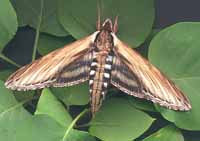 |
Sphinx kalmiae WO, Laurel Sphinx:
Lower fws predominantly brownish-yellow with fairly wide dark bar along inner margin. At rest wings hug body, giving the moth
long slender look.
|
 |
Sphinx luscitiosa USGS, Canadian Sphinx, Clemen's Sphinx:
This one is reported from Suffolk and Richmond and from northeastern New Jersey.
|
 |
Sphinx poecila WO, Poecila Sphinx:
If you have blueberries, you might have Poecila Sphinx.
Pretty common here on Prince Edward Island. It has not been
confirmed in Suffolk County. generally more northerly |
Smerinthini Tribe:
 |
Amorpha juglandis USGS, Walnut Sphinx:
This moth is fairly widely reported to the north, west and south of as well as in Suffolk.
This is the first Sphinx species I reared as a boy in New Jersey. See the file for the female; she is different. |
 |
Pachysphinx modesta USGS, Modest Sphinx, Poplar Sphinx:
This moth is recorded in Suffolk County. It is fond of poplars and
willows. They are common on Prince Edward Island. |
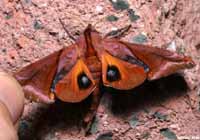 |
Paonias astylus USGS/HM, Huckleberry Sphinx:
Uncommon species. Recorded for Suffolk, reported for northeastern New Jersey
and Connecticut. Rarely seen in Maine. I never saw one in New Jersey.
|
Paonias astlus, Sag Harbour, July 22, 2011 Hugh McGuiness
 |
Paonias excaecata HM, Blinded Sphinx:
Named for dull grey-blue spot (minus dark pupil) in hw; wide distribution. Hugh McGuinness reports it June 3, 2003.
They are reported as far south as Florida. |
Paonias excaecata, Sag Harbour, July 22, 2011 Hugh McGuiness
 |
Paonias myops HM, Small-eyed Sphinx:
Named for the small eye-spot in the hindwing, this moth has a wide distribution and is probably common in Suffolk County.
I regularly see them on Prince Edward Island, and they are reported as far south as Florida.
|
| Paonias myops Sag Harbour, June 15, 2005; July 22, 2011 Hugh McGuiness |
 |
Smerinthus cerisyi
WO??, Cerisyi's Sphinx: Suffolk County would be close to the southern limit for this species in New York.
I never saw one in New Jersey. At my home in Montague, P.E.I., Canada, they are quite common.
|
 |
Smerinthus jamaicensis USGS, Twin-spotted Sphinx:
This moth is widely distributed and fairly common.
Along the East Coast, it flies from P.E.I. to Florida. |
Macroglossinae subfamily
Dilophonotini tribe:
 |
This species is reported in Suffolk where it makes an appearance as a
stray.
Males and females differ.
|
 |
Hemaris thysbe USGS, Hummingbird Clearwing:
This interesting day flier is reported in Suffolk, and is widely reported to the north, east and south.
Widely distributed in the east from P.E.I. to Florida. |
 |
Hemaris diffinis WO, Snowberry Clearwing:
This moth is widespread and has been recorded in Suffolk and Richmond and
in northwestern N.J. and southeastern N.Y. and Connecticut.
|
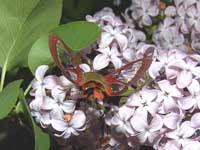 |
Hemaris gracilis WO, Slender Clearwing, Graceful Clearwing:
This day-flying moth is less common and has not been recorded in Suffolk, but has been seen in northeastern N.J. and southeastern N.Y. Questionable.
|
Philampelini tribe:
 |
Eumorpha achemon USGS, Achemon Sphinx:
Fairly often reported along the coast from southern New Jersey to central Maine.
Note the differences between this moth and the Pandorus Sphinx. |
 |
Eumorpha fasciatus HM,
Banded Sphinx: Hugh McGuinness reports a larva find. The moth is a strong flier and
occasionally moths and larvae turn up as rare strays in northern communities.
|
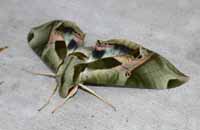 |
Eumorpha pandorus USGS/HM/JM, Pandorus Sphinx:
If you have Grape or Virginia Creeper nearby, then you probably have this species. I often get asked to identify larvae from areas not
previously reported. |
Eumorpha pandorus, Sag Harbour, July 22, 2011, Hugh McGuiness
Eumorpha pandorus, Smithtown, July 23, 2014, JM
Macroglossini tribe:
 |
Amphion floridensis USGS, Nessus Sphinix:
This day flier is widely distributed. If you have Virginia Creeper, you
probably have the Nessus Sphinx. It is reported from
Suffolk. Two bright, distinct, narrow yellow
bands are often visible on the abdomen.
|
 |
Cautethia grotei WO, Grote's Sphinx:
This species is rarely recorded in the U.S., but there are sightings in the east
from Florida, South Carolina, New Jersey, New York, Massachusetts and New Hampshire.
There are no reports from Suffolk. Questionable!
|
 |
Darapsa choerilus HM, Azalea Sphinx:
They are common in New Jersey and common here on Prince Edward Island.
You will often see this species listed as Darapsa pholus,
especially in older literature.
It is confirmed for Suffolk,
June 3, 2003, by Hugh McGuinness. |
Darapsa choerilus (2) Sag Harbour, June 15, 2005; July 22, 2011 Hugh McGuiness (pholus)
 |
Darapsa myron USGS/HM, Virginia Creeper Sphinx, Grapevine Sphinx:
Recorded on the U.S.G.S. site for Suffolk County,
widely reported as far north as southern Maine. If you have the
foodplants indicated in common names, you probably have myron. |
Darapsa myron, Sag Harbour, July 22, 2011 Hugh McGuiness
 |
Darapsa versicolor WO, Hydrangea Sphinx:
If you have hydrangea growing near a stream, then you may have the
Hydrangea Sphinx. It has not been reported in Suffolk, but, it has been reported in southeastern New York and
northeastern New Jersey. Questionable.
|
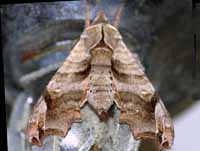 |
This species has been recorded in Suffolk and in surrounding areas. |
 |
Hyles gallii WO, Bedstraw Hawk Moth,
Gallium Sphinx: Reported in Richmond, but no further south in the
east. I suspect it would be rare, if ever present, in Suffolk.
Some years I see them on P.E.I., some years, I do not.
|
 |
Hyles lineata USGS, White-lined Sphinx:
Reported from Suffolk County. It flies across southern New York and has strong migrating tendancies.
There are records from New Hampshire and Maine. |
 |
Sphecodina abbottii HM,
Abbott's Sphinx: Very much under reported across the United States. It
is a rapid day flier so is probably not in too many collections.
Grape is a popular larval host. It is confirmed for Suffolk,
June 3, 2003, by Hugh McGuinness.
|
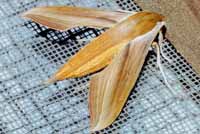 |
This moth is much more common to the south. it is a strong migrant, however,
and may establish itself in Suffolk.
|
|
|


